|
Selamat Datang! Welcome!
by Megan Wilson
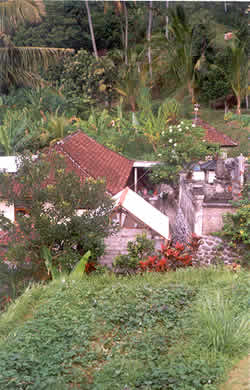 |
Bali, Indonesia
Photo Credit: Megan Wilson |
|
Last spring I decided it was time for a travel
adventure — something a little more challenging than weekend camping.
It had been nine years since I’d ventured out alone into the unknown
and spent six months driving through Mexico and Central America. It was
the most incredible experience I’d had — before and since. The
question now was where to next? I’d always wanted to go to
Southeast Asia, having spent my early twenties in Eugene, Oregon, where
it was practically a rite of passage to travel East to "find yourself"
(or cheap imports that you could bring back and sell at a 500 percent
markup). I was still interested in going there, but for different reasons;
now I was more curious to find alternative art communities and learn how
national and international politics and global consumer culture had affected
the region.
Indonesia was particularly appealing for this reason. I couldn’t
recall having ever heard anything about the country’s contemporary
art scene. I also knew that the political climate had been incredibly
tense over the past several years with the forced resignation of Mohamed
Soeharto in 1998. In addition, Bali is one of the most popular tourist
destinations in the world, making it fertile ground for seeing the effects
of global consumerism on a third-world nation. So Indonesia it was.
I did as much research as I could beforehand; however, the pickins were
slim with regard to contemporary culture outside of consumer interests
(gamelan, traditional dance, shadow puppetry, and so on). But as luck
would have it, a friend was able to connect me with Dan McGuire, a contributing
writer to Latitudes who has lived in Indonesia. Dan provided with
me a number of alternative resources. I learned that many people in Indonesia
speak some English due to the high number of English-speaking tourists
the country hosts each year. With this information and a Lonely Planet
guide in hand, I arrived in Denpasar on July 3, 2001.
Las Vegas of the South Pacific
 |
Bali, Indonesia
Photo Credit: Megan Wilson |
|
My first stop was Ubud on the island of Bali. Touted
as the cultural center of Bali, it’s an hour's drive north of Denpasar,
inland and still fairly south on the island. It’s made up of several
main streets, most prominently Monkey Forest Road, that run for a couple
of kilometers with many little roads interconnecting. It’s very beautiful,
yet in a seemingly staged way — a combination of Club Med, Las Vegas,
and Rodeo Drive (yes, they have Polo and Prada boutiques) in the South
Pacific. Everything seems to revolve around the tourism industry. Even
when I encountered beautiful temples, I found myself questioning whether
they were real or just another prop erected to provide island allure.
Each interaction also appears to be determined by the protocol of perceived
customer and the exchange of money. The question, Where are you from?
is asked not out of genuine interest, but instead as a way of sizing up
how much you can afford and at what price to start the barter. This is
followed by the next question, How much you pay? applied to anything
that you’ve purchased — accommodations, drivers, goods. What
soon became apparent is that tourism is now The Culture
on Bali — it is everyday life. Traditional dances, rituals, and crafts
are still practiced daily, but with the purpose of pleasing a foreign
audience to collect foreign currency.
Many Famous Artists
While having breakfast at my hotel on my third morning in Ubud, I
was approached by a rather suave, long-haired Balinese man dressed in
a pair of nice khakis and a T-shirt that said "Seattle" on it. He looked
to be in his late twenties or early thirties. I learned that his name
was Royan and that he worked as a guide and driver for the hotel. He,
as I’d come to expect, first asked where I was from and then what
I did for a living. I told him that I’m an artist and writer. He
then told me he’d be right back. He returned with a thick book full
of loose "paintings" of traditional Balinese images, ranging in style
from very detailed, like etchings, to looser forms and lines. He told
me that he, too, is an artist and that he’s the descendent of a very
famous Balinese artist. At the bottom of each painting, he was careful
to point out his name. He asked if I was interested in buying some of
his works. When I told him that I’d think about it, he moved on to
asking if he could take me out to the countryside — away from Ubud
— for $40. I offered $20. We agreed to meet the following morning.
Later that day, I saw the exact same "paintings" in several different
shops all with different names signed at the bottom. I asked one woman
who had painted them and she replied that her husband had.
Megawilson Meets Megawati
The next day, Royan and I headed out to explore the area surrounding Ubud.
Fields upon fields of tiered rice patties lined the landscape on such
a massive scale that it felt surreal to actually be there amidst terrain
that was so familiar through postcards and commercial images.
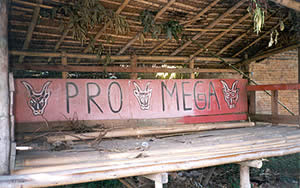 |
PDI Lookout Stations,
Bali
Photo Credit: Megan Wilson |
|
As we drove I noticed what appeared to be bus stops
— elevated platforms partially enclosed with bamboo walls and thatched
roofs — many spray-painted red and black with graffiti of a horned
creature and the tags "Pro Mega" and "PDI." I realized what those horned
heads depicted when I saw the image of a very sinister-looking bull painted
on the side of a house with the letters PDI placed above. I asked Royan
about the graphic images and learned that this evil-eyed steer is the
symbol for the PDI party (Democratic Party of Struggle) and is synonymous
with then-vice-president Megawati Sukarnoputri (known simply as Megawati),
daughter of Indonesia’s first president, Ahmed Soekarno. I learned
from Royan that 90 percent of Bali residents are supporters of the PDI
and they love Megawati. I was also told that the presumed bus stops
were actually lookout posts that had been built by the party during the
violent uprisings that led to the 1998 resignation of then-president Mohamed
Soeharto.
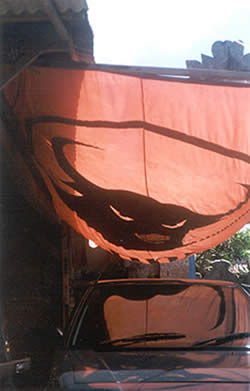 |
PDI Banner, Bali
Photo Credit: Megan Wilson |
|
The ubiquitous graffiti
and the lookout stations reflect the tense political climate that has
erupted over the past five years in Indonesia. The country has been witness
to extreme turmoil and violent disruptions prompted by a severe economic
crisis nationwide and a civil war on East Timor that resulted from the
Timorese vote for independence from Indonesia. In addition, the last three
years have seen four presidencies, including the forced resignation of
Abdurrahman Wahid while I was there on July 26 and his replacement by
Megawati.
Yogi? Jogji? What?
After a week on Bali, I decided I needed a change. Dan had highly recommended
Yogyakarta (pronounced Jojakarta or Jogja for short) on the island of
Java as having an underground and alternative arts community. It is also
the home of ISI, one of only three of Indonesia’s contemporary art
schools (the other two are located in Denpasar on Bali and Bandung on
Java). I was a bit nervous about the 24-hour trek on old, rickety buses,
but I decided the risk was worth it.
 |
Yogyakarta, Java
Photo Credit: Megan Wilson |
|
Upon arriving in Yogya, however, I began to question
my choice. Getting through the city at 2:00 in the afternoon is worse
than the traversing the Bay Bridge at 5:30 — horrendous traffic —
and the city itself appears to be a total armpit — many low, dilapidated,
nondescript buildings, overcrowded streets (Indonesia is the fifth most
populated country in the world), and heavy pollution (the sky is rarely
blue). On first take, it was pretty pathetic.
I was setting myself up to eat every one of those words. Yogyakarta became
my favorite stop on the trip, for its vibrancy as a supportive arts and
intellectual community. I found a great hotel not far from the art school
(and, I would later learn, the alternative galleries) for seven dollars
a night. My first night there, I was awakened at 4:30 a.m. to Islamic
chanting being broadcast throughout the city by loudspeaker. For a moment
I thought I was in yoga class and had drifted a little too far during
meditation. This broadcast would occur four more times throughout the
day, every day, providing precious moments of reflection that have become
lost in the hustle and bustle of our culture here.
Universal Art School
Walking through the campus of ISI on the outskirts of Yogya, I felt like
I was a student back at the San Francisco Art Institute — lots of
art kids hanging out on the steps of two of the dilapidated buildings
— mostly boys smoking cigarettes and looking cool. When they saw
me the jeers came on full force — lots of whistling and heckling.
I was happy not to know the language at that point — though in retrospect,
I would love to know what they were saying.
 |
ISI Campus, Yogyakarta
Photo Credit: Megan Wilson |
|
I found out the school's gallery was between shows,
and the next one would open the following week. I ended up talking to
a young man wearing a shirt that had a comic book page design on it. I
asked him about the comic book scene in Yogya and learned that he’s
a comic book artist who teaches at the school (though he looked more like
a student to me). His name was Bambang Toko and he was a part of an underground
(but well-known in the art community) collective in the nineties called
Apotik Komik. He gave me the names of fellow comic book artists and other
art resources, including the Cemeti Gallery, which Dan McGuire had also
recommended. He told me that if I came back on Tuesday morning for the
opening, I could interview him and the other artists from Apotik Komik.
Cemeti Art House
I headed over to the Cemeti Gallery
by becack, a three-wheel cart powered by a driver on a bicycle
— a good way to see Yogyakarta and to help support some of the lowest-paid
laborers in the city. Gallery manager Nanuk Ambarwati was very helpful
and offered a number of resources — catalogs, comic books, artists'
books, and magazines. One catalog from a
traveling exhibition the Cemeti had organized last year, which is touring
in Germany, then to Jakarta called Awas! (meaning take care/beware)
features the work of 14 artists and artists’ collectives, including
Apotik Komik, whose work reflects on Indonesia’s recent political
climate. Nanuk also showed me a book the Cemeti Foundation had published
called Outlet that provides a great overview of Yogya artists within
the greater context of new work being produced throughout Indonesia.
 |
| Cemeti
Art House |
|
San Francisco’s Southern Exposure Gallery
kept coming to mind as I was there — the large, open space, relaxed
community-based environment, and largely installation and performance-based
exhibitions I was seeing in the gallery’s slide documentation.
Apotik Komik: Comic Pharmacy
I returned to ISI the following Tuesday to see
the annual end-of-the-year student exhibition and to meet up with Bambang
and Apotik Komik. The show was a graduation exhibition divided up into
sections — architecture and design, painting and sculpture, craft,
and printmaking — like any Western art school. However, unlike most
of the art schools here, the show didn’t present any media work.
There were a few good pieces, but it’s always hard to get a good
sense of anyone’s work in survey shows.
Bambang showed up with Arie Dyanto and Popok, two of the other three members
of Apotik Komik (the fourth member, Samuel Indratma, wasn’t able
to make it). All very cute — Arie and Bambang both looking the part
of the irresistible bad boy and Popok countering with the clean-cut, fit-to-take-home-to-mom
image.
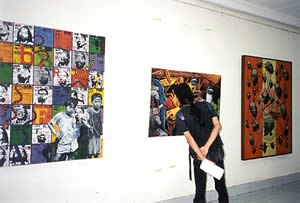 |
Graduation Exhibit,
ISI
Photo Credit: Megan Wilson |
|
I interviewed them on the steps of the entrance
to the gallery. Arie acted as primary spokesperson since he spoke the
best English, while Bambang and Popok added comments in limited English
(though they could understand English quite well.) I learned that Apotik
Komik was a collective of artists who began working together in 1992 to
create public works generally not related to traditional exhibition venues.
Their goal was to bring art to the public rather than waiting for an audience
to come to an art space. Over the past year the group has ceased working
together collaboratively to pursue their individual interests and projects.
Talking with them, I was intrigued by how similar they are in their approach
to their work to many of the artists I know in San Francisco. They have
a strong social consciousness interlaced with humor and work with a bold
aesthetic and strong commitment to craft, yet often present their projects
in funky settings that guarantee an ephemeral experience. Following the
interview, we headed over to a friend of theirs' place to check out his
comic book collection. All five of us sat crouched on the floor of his
tiny apartment flipping through Indonesian comics. The whole scene triggered
vivid flashbacks to the many hours my friends and I would spend at college
hanging out listening to music and reading RAW in a cramped but cozy space.
Homeward Bound
I spent the remainder of my time in Yogya visiting the Cemeti Foundation
and learning more about the city’s alternative art community. I checked
out a few more shows, including Tiarma Dame Ruth Sirait’s Sweet
Lolly (Stretcher 1.5 Fall 2001). I continued to be impressed by the
quality of work — conceptually and visually. I would like to have
stayed longer, however nerves were running a bit tense among travelers
in the wake of the removal of President Wahid, scheduled for August 1.
The presence of tanks on the streets and military jets flying overhead
did not help ease the anxiety. As it turned out, the change of leadership
in the country was very peaceful. Wahid voluntarily resigned on July 26
and Megawati stepped in to become Indonesia’s president.
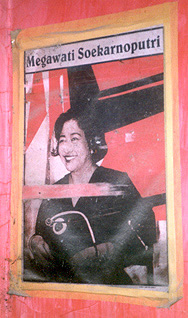 |
Megawati" Sukarnoputri
Photo Credit: Megan Wilson |
|
My final week in Indonesia was spent on the eastern
coast of Bali in a fishing area called Amed, though most of the fish are
gone, as is the beautiful bright-colored coral that once covered the coast.
This locale couldn’t have been a more perfect choice. I stayed in
a bungalow on stilts just 40 feet from the ocean. I read, wrote, made
drawings, and slept under a blanket of stars every night. One morning
I even got up at 4:30 and sailed two hours out into the middle of the
ocean with a fisherman on a small boat that looked like a cross between
a kayak and canoe. We watched the sunrise and I held on for dear life
during the turbulent ride back to shore, since I don’t know how to
swim and had neglected to bring a life jacket along. Still, it was a perfect
metaphor for the whole trip — setting out for the unknown and trusting
the outcome — which in both cases provided me with great, life-changing
experiences.
Postscript
I am still in contact with the Cemeti Foundation, Apotik Komik, and
Tiarma Dame Ruth Sirait. The Cemeti and I are currently in the process
of organizing an exchange show of artists from San Francisco’s
Clarion Alley Mural Project and Yogyakarta’s Apotik Komik. I’m
looking forward to returning next summer and to the dialogues and experiences
that we’ll share with each other. I’m also looking forward to
bringing Arie, Bambang, Popok, and Samuel to San Francisco next fall to
be a part of their first experience in the U.S. and to spend a little
more time nattering with them. Interview
with Apotik Komik
|








